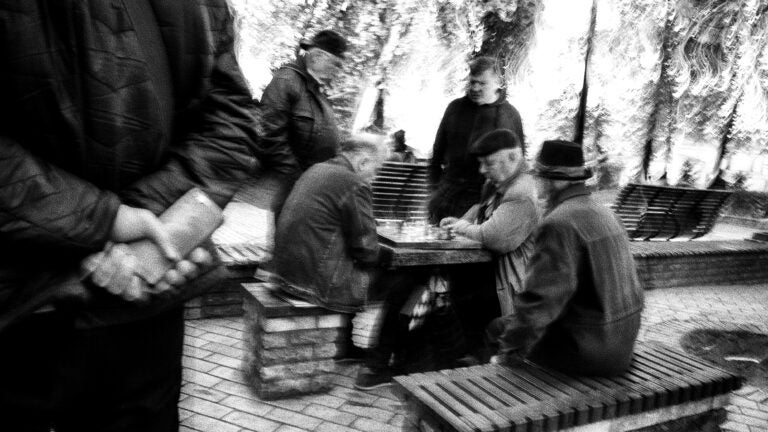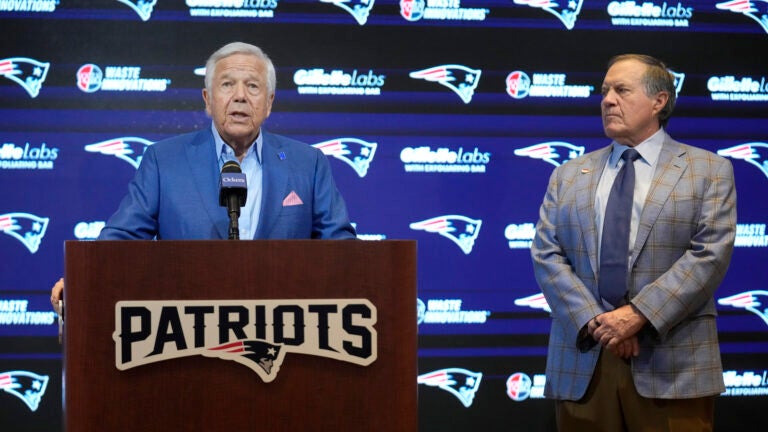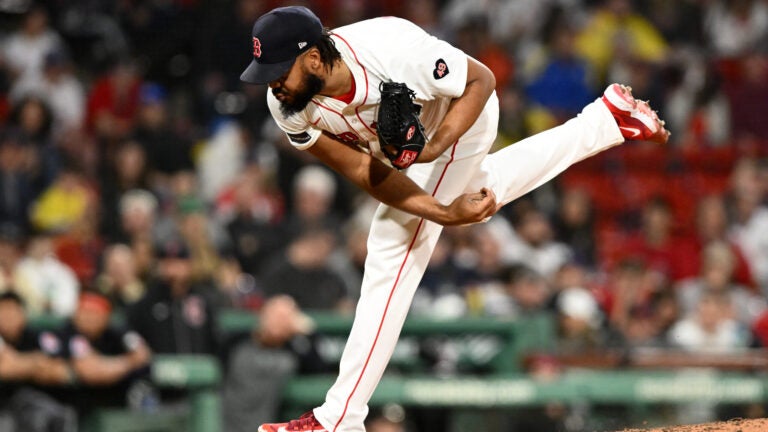The dark side of chess: Payoffs, points, and 12-year-old grandmasters
“I believe it is possible that if I went to the effort, I think I could get my dog a grandmaster’s title.”

KYIV, Ukraine — Sergei Karjakin had only one game of chess left, and he had to win it.
It should have been an easy task. The opponent was the lowest-ranked player in the tournament. Karjakin was one of the rising talents in chess, a poised and accomplished boy of 12 years 7 months who was, at that moment, one victory from becoming the game’s youngest grandmaster.
The title would change his life. In chess, only the Top 30 players can expect to build a proper career from the game. Becoming the youngest grandmaster in history offered Karjakin a direct path to that world, a door to global acclaim and corporate sponsorships and invitations to the biggest tournaments — to the life that he and every prodigy, and, perhaps most of all, their parents dream about.
But first Karjakin had to win one last game.
For once, though, his skill did not appear to be enough. For nearly 60 moves, Karjakin posed subtle and challenging problems to Irina Semyonova, his opponent. Each time, she had an answer, a counter. Karjakin kept pressing, but the game ended in a draw.
Suddenly, all of what had been close enough to touch — the label, the fame, the history — was slipping away.
But the aspiring grandmaster and his team still had one audacious move left.
Fathers, sons and points
Chess grandmasters are not made in a day. Even the brightest talents need years to earn the highest and most coveted title in the game. To achieve it, a player must gain a high rating through strong tournament play and by collecting a series of bench marks, called norms, in games at qualified events.
For the three decades after the title was formally introduced in 1950, the grandmaster was a rare species. Other players knew not only their names but their playing styles, too. They were treated like stars at tournament and appearances.
That all changed in the 1980s, when FIDE, the governing body for chess, started expanding into countries that did not have established chess cultures. To pursue its goal of having at least one grandmaster in each country, FIDE relaxed its requirements.
That change made the label more accessible, but also less exclusive: Nearly 2,000 players have become grandmasters since 1950. Gradually, the label ceased being a ticket to a great future in chess. Young players — and their often obsessive parents — needed something to set them apart. The title of the youngest grandmaster turned into one such springboard.
For Karjakin and his father, Alexander, the label held almost infinite promise. By becoming the youngest grandmaster, Karjakin would, in an instant, assume a title once held by Boris Spassky and Bobby Fischer, one that even world champions like Garry Kasparov and Magnus Carlsen had never earned. The achievement would make the 12-year-old Sergei Karjakin a household name in chess. It would open doors.
Karjakin had worked his whole life toward this goal. Born in Simferopol, Crimea, in 1990, he was playing chess for six hours every day by the time he was 5 years old. Through talent and devotion he quickly developed into one of the most promising young players in Ukraine.
The Momot Chess Club, the country’s most prestigious chess school at the time, took notice. It invited Karjakin to join its ranks in the town of Kramatorsk, a rusty industrial wreck in Ukraine’s east. With little to keep them in Crimea — Karjakin’s parents had become street vendors to make ends meet in the ruins of the post-Soviet Union economy — the entire family moved with its chess-playing son.
For the Karjakins, the Momot club was an island of opportunity in a country terrorized by economic transformation and gang wars. By the time they arrived with Sergei it had started producing champions and grandmasters at the speed of an assembly line. At one point, Momot counted three of the 10 youngest grandmasters in the world among its members. Ruslan Ponomaryov, the club’s first star, was the world knockout champion from 2002 to 2004.
Karjakin quickly rose to become one of the stars of the school. His success, and the strong bonds his father was forging with coaches, meant Karjakin got the school’s backing in tournaments. Those appearances, and his success, propelled his preteen reputation.
But for some players, securing a prestigious title meant more than just playing well. It is an open secret in chess that many players cut side deals with tournament organizers and other top competitors that help them achieve norms they might have struggled to get legitimately.
This culture touched the Momot club. Many of its members acquired their grandmaster credentials in Crimea, at tournaments in places like Sudak and Alushta that were known as “norm factories” — where, for as little as $1,000, organizers would make sure players accumulated enough points for a norm.
But there were other, more subtle, ways to succeed, too. Far from prying eyes, secret agreements and cash exchanges to arrange results were not uncommon, according to interviews with chess players and FIDE officials. In a sport so wholly obsessed with status, title and rank, even selling a game could be accomplished for the right price.
Mikhail Zaitsev, who achieved the rank of International Master and is now a chess coach, estimated that of the world’s roughly 1,900 living grandmasters, at least 10% have cheated one way or another to acquire the title. Shohreh Bayat, one of the leading arbiters in chess, describes such arrangements in the plainest terms. “Match fixing,” she said, “is cheating.” Some hopefuls didn’t even have to play a game of chess to get the points they needed: Some tournaments, she said, took place only on paper.
None of this is lost on the sport’s frustrated leaders.
“We have a dog called Pasquales,” said Nigel Short, the vice president of FIDE. “I believe it is possible that if I went to the effort, I think I could get my dog a grandmaster’s title.”
Games sold
The Great Silk Road tournament, where Karjakin became the world’s youngest grandmaster in 2002, was held in the picturesque town of Sudak on the Black Sea. It was a mess, according to interviews with five people who were there.
The winner was Vasily Malinin. How he won was another matter. Alexander Areshchenko, a young player at the time, said Malinin paid Areshchenko’s mother in exchange for a victory in their match. Another player, Nazar Firman, said he was also paid.
Malinin, who died in November, always denied paying for results. But in a letter published in Russian on an obscure chess website, he acknowledged playing an unusual role in the Sudak tournament.
The most notable game, he said, was one he agreed to lose.
Malinin told the story this way in his letter:
With Karjakin’s title as the world’s youngest grandmaster slipping away after his unexpected draw with Semyonova, Karjakin’s father, Alexander, approached several players to whom his son had lost points and offered them money to replay their games. Firman said he was among those to receive an offer of cash for an arranged draw.
Malinin, who had points to spare, agreed to replay his game with Karjakin. He said he did so for free and therefore did not consider it cheating. The two replayed a game that normally would have taken up to six hours; in the replay, Malinin said, it was played “in a blitz” — a high-speed variant of chess. Karjakin won.
Minutes later, the newly crowned grandmaster ran into the tournament’s main hall, radiant and proud as “a peacock,” according to Areshchenko, who was present.
Asked about the episode in an interview with The New York Times, Karjakin said he would ask his father about it. He later said that he is not in touch with his father and had no further information about the tournament. Phone calls and text messages sent to Karjakin’s parents were not answered.
The fruits of Karjakin’s victory, though, came quickly. The next year, he played at the tournament in Wijk aan Zee in the Netherlands, a town known as the Wimbledon of chess. In Paris, he joined the prestigious NAO chess club. Only a few months earlier, Karjakin had traveled to tournaments in Europe by bus. Now, as the world’s youngest grandmaster, he was greeted by the president of Mexico.
“I was just swarmed with invitations,” Karjakin said in an interview, talking about the aftermath. “I became widely popular.”
Competing against the world’s best players, Karjakin progressed rapidly. By October 2005, when he was 15, he was already ranked among the Top 50 players in the world. In 2016, at the World Chess Championship in New York, he was on the cusp of becoming world champion before losing to Norway’s Carlsen, considered the world’s best player then and now, in a tiebreaker. And for more than 18 years, Karjakin, now 31, held a title no one could match: the world’s youngest grandmaster.
The stain of what had happened in the Sudak tournament, however, has lingered. There were rumors about the event in the chess world, but no one seemed interested in pursuing them. Several participants in the tournament said that Karjakin had not achieved his grandmaster’s title by the book, but that, for them, it was just a fact of chess life.
Areshchenko, a stronger player than Karjakin at the time and his classmate in a chess club, said that his coaches had told him to play a draw with Karjakin to make sure he got the youngest-grandmaster title on time.
“He could not do it honestly,” Areshchenko said of Karjakin. “I played better than him at the time, and it was tough for me to become a grandmaster then.”
In an interview, Karjakin denied offering payoffs or making side deals. He said it was Malinin who had tried to extort money from his family for simply playing a game that they had agreed to postpone, not replay. After Karjakin’s father refused to pay, Malinin got mad and “made up all that mess,” he said.
“My father came to him and told him that he has to go and play with me,” Karjakin said of Malinin. “In any case, nobody would engage in negotiations with young children.”
A visit with Putin
Many chess players say making side deals in chess is essentially harmless. But to others, Karjakin’s career has demonstrated that is not the case.
Players who fulfill their norms honestly, other players said, would not get their grandmaster’s title for years, and thus never get the chance to join the top echelon. Firman, for instance, has quit professional chess several times because of his inability to make a living at it. At least one of Karjakin’s former peers at the Momot Chess Club now earns money giving Skype lessons. Others compete for small prizes in sweaty halls at low-level tournaments.
Karjakin, however, has thrived. In 2009, President Dmitry Medvedev of Russia granted him citizenship. In 2014, Karjakin sided with Russia against his native Ukraine by openly supporting its annexation of Crimea. In Crimea, he posed in a T-shirt bearing the face of Vladimir Putin, of whom he was by then a prominent and vocal supporter.
In 2016, Putin said that “the country has always given high priority to chess, and chess has always helped the country.” The chess crown, however, has been away from Russia since 2007, when Vladimir Kramnik lost it to Viswanathan Anand of India. Karjakin has promised to “bring the chess crown back to Russia.”
He received full support for that effort. Lucrative contracts with Russian corporations have bankrolled Karjakin, including one with a bank that brought him around $300,000. His face appeared on billboards around Moscow, and he was invited to the most popular talk shows, turning into a celebrity. He received a manager and an apartment. Soon, he had a country house, too, in the most prestigious area outside Moscow, as well as a Mercedes with a driver.
In 2017, Putin even invited Karjakin to his residence. In his office, Putin’s first question was: “You became a grandmaster at 12, didn’t you?”
“Yes,” Karjakin said. “I was the youngest.”
A worthy successor
On the last day of June, 18 years after he had claimed it, Karjakin surrendered the title that had launched his career.
His successor as the youngest grandmaster in history, a young boy from New Jersey named Abhimanyu Mishra, broke the record by two months, gaining the title at the age of 12 years 4 months 25 days. Mishra and his father are hoping the achievement will do for him what it did for Karjakin.
Like Karjakin’s parents more than two decades ago, Mishra’s father, Hemant, had a lot at stake in seeing his son claim the title. He said he spent more than $270,000 on making his son the world’s youngest grandmaster, and he had been collecting donations online to make their chess dream come true. The small advantages that the money could buy — in scheduling, in opposition, in timing — began to add up as he closed in on his final norm.
Mishra, who described Karjakin as his idol, played in five so-called norm tournaments in Charlotte, North Carolina, in the fall of 2020 and spring of 2021 but did not achieve a single norm. With the deadline to beat Karjakin’s record bearing down, he and his father next traveled to Budapest, Hungary, where Abhimanyu Mishra played eight tournaments in a row.
At these tournaments, norm-seekers paid the organizers, who in turn paid grandmasters to show up, a legal and common arrangement in professional chess. But the quality was not the same; the average rating of Mishra’s opponents in the Budapest events was nearly 50 points lower than it had been in Charlotte.
In an interview, Arkady Dvorkovich, the president of FIDE, said that there is little sportsmanship at such tournaments. That is partly because the grandmasters, often aging players long past their prime, often lack the motivation to work hard to beat their opponents. “The motivation was quite low for me,” said Vojtech Plat, one of the grandmasters who played.
At the Budapest tournaments, Mishra had the added advantage of playing against the same group of grandmasters again and again, which allowed him to learn their tactics and styles.
Gabor Nagy, a Hungarian grandmaster, played against Mishra in six of the tournaments in Budapest. (In Charlotte, no grandmaster played in more than three tournaments.) In one match, they agreed on a draw after 13 moves, and in another, after only six. To chess experts, this was an indication that the matches were not seriously contested. But in playing them, Mishra accumulated a precious half-point toward his goal in a matter of minutes.
In another tournament, Mishra played three games in a day, his father said. FIDE rules, which seek to protect players from overexertion in the grueling sport, set a limit of two games a day. By the time Mishra had usurped Karjakin’s throne, he had played 70 games of chess in only 78 days.
“It begins to smell,” Bruce Pandolfini, an accomplished American coach, said of the effort to chase the youngest grandmaster title using those methods.
Still, Mishra’s rise to grandmaster will mark the start of a new life for him. He was recently featured on the websites of ESPN and People magazine and was invited to the upcoming Chess World Cup, one of the most prestigious tournaments in the sport with a purse of nearly $1.9 million.
Hemant Mishra said his son achieved the title legitimately and that suggesting otherwise would be “utter nonsense.” But top players are publicly questioning Mishra’s title and criticizing the system that helped him get it.
Short, a grandmaster himself and the FIDE vice president, said that he had attempted to reform that system. But the fact that so many players had already acquired questionable grandmaster titles made it all but impossible.
“The horse has bolted; you cannot close the stable doors,” he said. “The best thing to do is to abolish the title altogether.”
This article originally appeared in The New York Times.







Conversation
This discussion has ended. Please join elsewhere on Boston.com